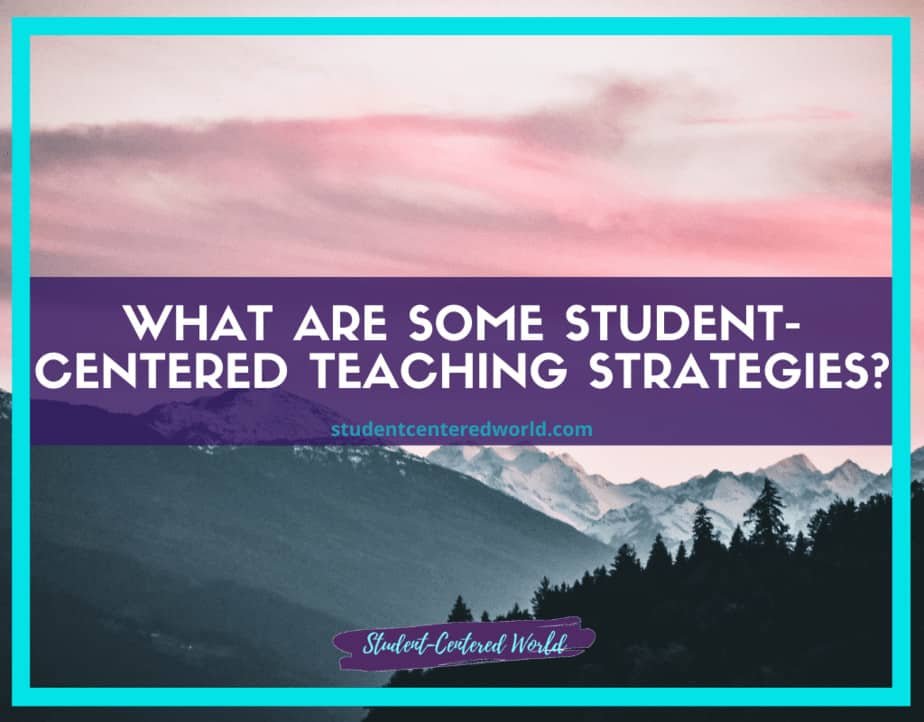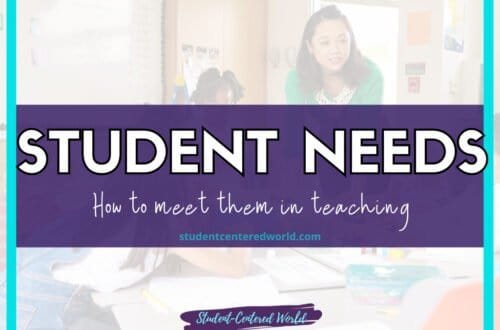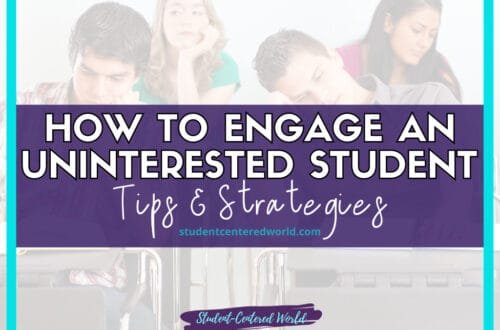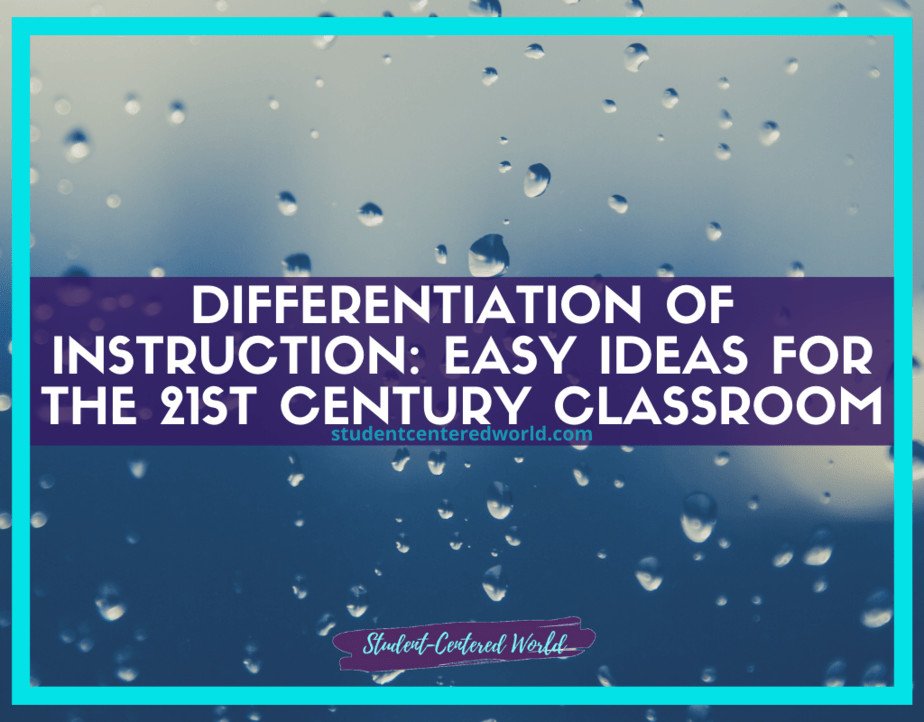Theories of Educational Change in this Crazy 21st Century
Click above to listen to this podcast episode. Below is the transcript for Student-Centered World Podcast Episode 29: “Theories of Educational Change: The Silver Linings of our Current State of Education“
Please Note: In this week’s podcast, we’re going back to a Facebook Live I did back in spring 2020, not long into the school shutdowns. While some of the chatter is a little more timely for that period, after listening to it I realized it was a larger message that so many teachers needed to hear RIGHT NOW. The advice ends up being timeless….or until the crazy of all of this finally passes.
Hey, welcome. I hope you guys are having a relaxing weekend. Yesterday I had posted in the group about name one thing that you did, even if it was nothing, and it was probably one of the hottest posts that we had so far. People in there with yard work or taking the dog for a walk or lesson planning or taking a nap or whatever it was, a lot of people were doing a lot of things for them. That was fantastic.
I had shared a post this week about work-life balance and it’s really easy to drop into this idea of you’re working all the time. You wake up, you check your phone, you go to the computer, you’re working all day long. People, administrators, students, parents think that you’re available at all times. Then you go to bed, but you’re still on your phone.
So, it was a whole article about how to break that cycle, especially early in distance learning as a focus on theories of educational change. Because if you set the precedent, it’s going to not work out well, you’re going to burn out with it really quickly. We don’t know how long-distance learning is going for. So, that’s certainly something if you haven’t taken a look at that article, make sure that you do so.
But what I wanted to come on here and talk about the silver lining of this whole situation. True theories of educational change. I know that’s really hard to put into perspective. We know, it’s scary. My husband just went to the hardware store for something and I was spraying him down with disinfectant when he got home. He was yelling at me and it was a whole thing but it’s scary out there.
We want to make sure that we’re safe and we don’t know what’s going to happen next. It’s crazy. But it’s really helping us if you want to look at that silver lining, get back to the basics and theories of educational change.
So, we’re all at home, and we’re trying to manage being teachers at home. But when you’re not teaching, you’re not being rushed to make it to this place or that place. Everybody is home and we’re getting back to having conversations, having meals, taking time, reading the book. Again, go through that feed that I had yesterday of just all of the different things that people were taking time to do.
That’s something to really kind of consider in all of this. There’s a lot of self-care that’s going on. If you haven’t started that yet, take a breath and start that process. Make sure that you’re exercising. There are so many gyms and stuff that are streaming things online, or if you have a neighborhood that you can go out and walk in without having social distancing issues. Now is the time to start good habits in theories of educational change, okay.
Grasping the theories of educational change as noted
It’s also helping very much with teaching methodology. So, we know that we’re teaching a very tech-savvy generation right now. They are Generation Z. I talk about this a lot in my business, but they’re very, very tech-savvy, they’re very interested in information if they get hooked by it. So, that’s why they’re very much the YouTube generation. If they want to know the answers to something they are on the internet, on YouTube, looking at videos, finding videos, going through to get what they want out of it.
So, this method of teaching, even though we’re trying to find that balance still is very much in tune with the way that they’re learning when they’re interested in something on their own and is huge in pondering theories of educational change. So, my business for anybody who’s not familiar or hasn’t been following me for a long time is all about helping teachers create hands-on lessons for the generation that we have in the classroom now.
So, this feeds into that whole entire concept. We have a situation now tying into all of that, where we’re no longer teaching to the test if you want to consider that. A lot of state testing has been canceled. If yours hasn’t yet it could be coming, a lot of things are changing, but we’re not teaching to the test. So, it’s giving us an opportunity, for the first time ever to separate ourselves from the way it’s always been done, to let’s try some new things.
I want you to take that as the biggest silver lining of all of this. You have the opportunity to live these theories of educational change. We’ve been in professional development before. We see the teacher down the hallway, trying this, and trying that. We might want to try it, but we don’t have the opportunity, or we’re scared to do something different in our classroom. We have something in front of us right now that is different than we’ve ever had before.
There are no best practices for what we’re doing now. Sure, distance learning has best practices but what we’re all doing is not something that has been crafted as a curriculum for distance learning. It is not a school that has been crafted for distance learning. So, there are no best practices that are in place for what we’re doing right now. So, take that moment and seize it.
Now is the time to try all the new things in terms of theories of educational change. There’s nothing wrong right now, if something doesn’t work out, it’s not the end of the world. It’s you taking the situation, seizing it, and trying to do new things because all of this is new. I can’t emphasize that enough. This is an unprecedented opportunity for educators to embrace the theories of educational change.
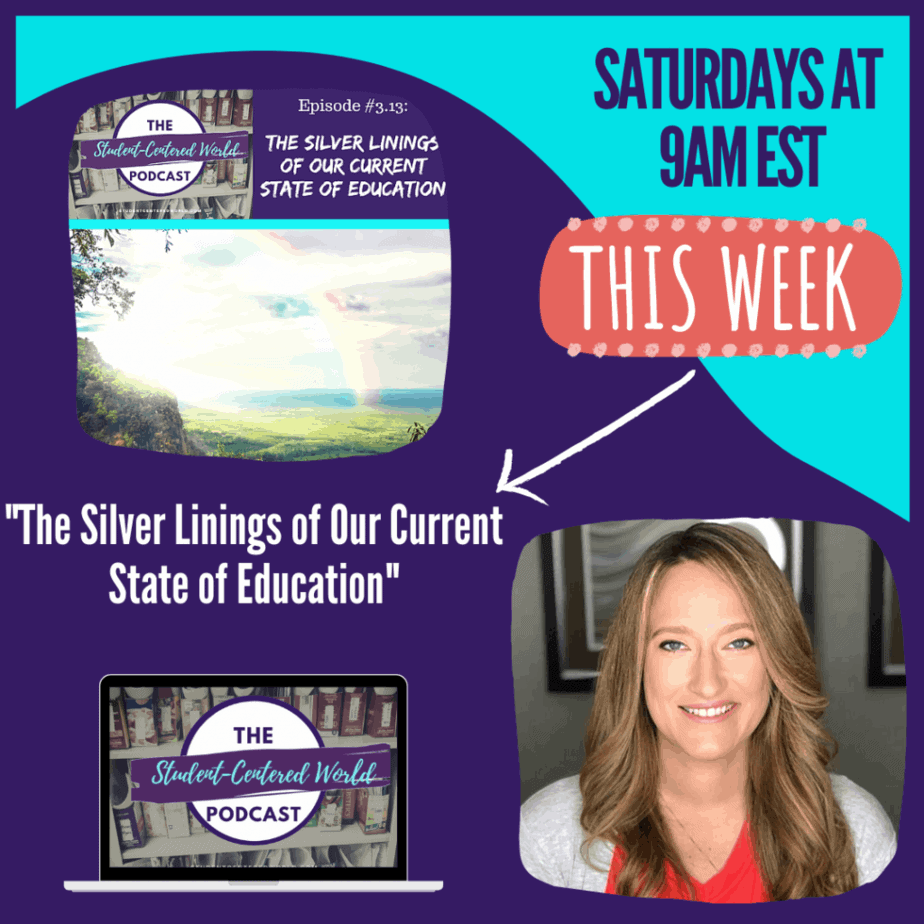
I want you to think of it that way. It’s an opportunity to do the new things, to try the new things to learn the new things, okay, and not be inundated with but when I get home, I have to go here, I had to take my kid here we have to do this. We’re all home right now, there’s no place to go. If you’re like us, we’re already kind of running out of home projects, because we’re doing them because we’re home and that’s kind of what this weekend has been for us. You’re going to run into that with teaching, too.
Now is the time to try the new
So, try new things. I can’t emphasize that enough. This is our opportunity to actually do something and when it comes to doing something, this is the other silver lining. This is one of the first and possibly only times that a lot of the concerns that we had had about teaching and education and inequities, and special education, and all of that is coming to the forefront in the mainstream conversation.
We’ve been complaining about stuff for years. You have, I have, everybody has, but it’s not something that’s been put on the front burner. Some districts have, don’t get me wrong, but as a mainstream thing that has not been put on the front burner. Now it is. So many schools are we’ll do distance learning, kids don’t have internet. Okay, I shared an article on that too, about what you should do if you’re having trouble connecting with your kids at home. If you haven’t read that, please take a look.
Okay, but we have all of these issues that are now showing the inequities in education. We can sit back, and we could say, see, I told you so. Okay, we could sit back and say all kinds of things.
Now’s the time to do something. We have the opportunity to do something. Be one of the people that say, “you know what, in our districts in my school in my classroom, this is the problem right now. This is what I’ve been trying to tell you for a long time. What can we do to fix it?” Some of the stuff can’t be fixed, or it can’t be fixed without a long-term plan. But start talking about the plan and incorporating the theories of educational change. This is the first time that we are actually having the opportunity where it’s almost like the slate is clean. Let’s figure out where the problems are.
Let’s figure out what the issues are and start having real conversations on how to fix them and implement theories of educational change. If you’re finding yourself in a district is having a really tough time getting a hold of your students, getting a hold of their families, back it down a little bit.
Again, we’re not teaching to the test. So, that’s a really big part of it and one of those huge theories of educational change. I know some schools are trying to finagle how this grading and all that’s going to go. It’s going to change a bunch more times. I can almost guarantee it as people are finding what’s working and what’s not. But this is the time for relationships, making sure you’re having relationships with your students, with those families. Again, in that post, I have written different things that you can do to try to get a hold of them. But the ones that you do have the ability to communicate with.
It’s all about the relationships
Here’s the word I’m looking for, make sure you keep those relationships strong because the students will be more likely to do things if you do have those strong relationships. Make sure that you’re making time for your co-workers, that you’re having conversations with them. What’s working for you right now?
You have all the same kids at the end of the day. What’s working for you? What can I try? Here’s what’s working for me, maybe you should try this out. This is the time for all of that. Okay. The other piece I want to put out there is the concept of doing fewer things better. Again, blank slate. You can’t do at home what you can do in the classroom. You just can’t. It’s not possible. You can get close, but you can’t quite get there.
So, figure out what do you want the dynamic of your class to look like? Will there be video conferencing? Will there be paperwork where there’ll be digital work? Are you finding simulations, virtual field trips? Do they have stuff at home to do art-type projects? You’ve got to figure out what you want it to look like, what theories of educational change you want to try, and find a couple of pieces and do them really, really well.
One of the things that I teach when I am working with teachers is that old concept of the KISS method of instruction? Keep it simple, stupid. The more simplified you have things, the easier it’s going to be for the students to engage with them. You want engagement with them as much as possible, I know that there are issues, but figure out what’s going to work for your kids, and do those things really, really well. We have to cover this topic, Think, how can I make this easy, but effective and that’s the main thing.
Don’t try to reinvent the wheel, don’t try to have all of the different pieces. We want this core thing achieved. What is the easiest way that I can make that happen? Okay, step out of your role that you’ve been as a teacher where you’re trying to cram all the things. Stop. How can I take this and make it the most effective most bang for your buck, lesson activity, resource, whatever, for my students to learn what they need to learn at this moment? That’s going to help your students in the long run too.
I posted on my own personal social media, to my friends who are trying to manage facilitating teaching their kids at home, that they need to have time during this whole thing where they’re completely unscheduled. There are so many kids right now going into adulthood that aren’t good problem-solvers because they’ve always had all of their time scheduled for them. So, by doing a method of instruction that’s going to have the best bang for your buck and incorporate those theories of educational change, how can I make this easy and effective when I need you guys to go off and do this, this, and that.
I always say kind of give them enough rope to hang themselves and then you’re obviously there to help them with that. That’s your role in all of this. But it gives them some autonomy, and it gives them responsibility. Make sure it’s age-appropriate. Don’t expect a fourth grader to be able to do what a 12th grader can do. But you’re giving them the tools to gain independence and to be able to work on their own and problem solve and figure things out.
We’ve been working with that a lot with my kids at home. My older one, he’s in third grade, and a lot of times if something doesn’t work, he throws up his hands. He’s like, “I don’t know, I can’t do it”. So, we’ve been working a lot with him of like, what’s Plan B? What’s Plan C? What else can you try? This is a good time to try to instill those values and theories of educational change in your students if you can.
We say all the time that we need to be working on soft skills because this generation is lacking soft skills. This is a good time to incorporate all of that because they’re not right in front of you.
You don’t have the ability to go over there and put your hands on something and help fix it. Okay, this is the time to teach them that autonomy that they are lacking a little bit because of how we’ve evolved as a society, I really feel that this is a moment where you know, wherever you are spiritually, the universe, if you will, is telling everybody to slow down and like I said go back to the basics, find out what matters.

Where do we go from here?
What can we learn from this? How can we simplify it so we can get on to the other things that are important? I think it’s important as your lesson planning to make sure that you have those ideas rolling. I have all my notes right here and I just lost my spot. The last thing I want you guys to consider in all of this, and I’m talking really fast, I wanted this to go for like a half an hour and if I could figure out where everybody is in case they’re commenting. I still can’t find my video on my computer.
So, if you’re asking questions, I promise I will come back to them when I am done. But the last thing I want you all to consider is making sure no matter what the bottom line is, if your school your district, your own mind that you are prioritizing human need over driving content 100%.
We always talk about it’s important to maintain those relationships but in the back of our mind, we’re always pushing that content, making sure we can teach to the test, thinking about theories of educational change, so on and so forth. Our kids are scared, their families are scared. There are people that are sick, becoming sick. Parents are still out working; kids are worried about their parents that are out. The parents are worried about coming back and trying to get all this stuff together, possibly having something and passing it along.
It’s a mess right now. You need to make sure that your students’ needs as human beings are being met as much as you can. Obviously, we’re not miracle workers here but there’s nothing wrong with starting every day with some type of quiz of how you doing. You can do a Google form, completely anonymous.
If you’re doing what I’ve suggested to a bunch of teachers and you guys may have been one of them. If you’re doing some type of a video chat where they can see your screen. You make up a Google form that has the different I’m good, whatever you think it should be part of. On your screen, you can have the pie chart as it’s filling in on what everybody’s answers are. But it’s completely anonymous except for you.
So, after the fact, you can go through and see where your kids are in just maybe needing someone to talk to or someone to understand or there’s a situation going on or whatever the case is that you can go back and have that moment if you need to connect with them. So, that’s a really easy way to keep that human connection going.
They might not be truthful, okay but if it’s anonymous, to their classmates, they have more of a chance of being truthful with the whole situation. So, that’s something really to consider.
Before all this started, before I even started this group, I had written an article about making this whole process inquiry-based. I was on the news for it, there was a whole thing. It’s all about preparing for the situation of the schools closing, we’re obviously there. But a good way to roll in with all of the stuff that I was talking about, I do like this, like you can see my list.
But a good way to make sure that you are meeting all of these pieces, especially if you’re trying to put it all together is to let the kids do some inquiry-based projects especially if you’re at a school, it’s not allowing you to teach new content, which I know a lot of districts are doing that. Have them do an inquiry project based on a topic that you discussed, that really interested them, or something that can connect to current events somehow, or just something that they are excited about personally, they can engage with.
It’s all about the Inquiry
There is a whole list of things that you can do with that concept. I won’t get into it now, per se, because I don’t know what specific questions people might have. But if that appeals to you, but you’ve never done anything inquiry-based before we could start a thread, maybe in the group, and discuss that. It’s a really easy way to keep your kids engaged, keep them interested.
Then you can fall under every category that your school is, even if you are teaching new content. You can have them do an Edpuzzle if you’re a one-to-one school where it goes over the content and then it’s what questions do you have about it? What can you relate this to that’s going on right now? Making those connections. If you aren’t doing the computer stuff, and you are doing worksheets or paper-based stuff, this is great.
You can write out a list of different questions, or there are just so many opportunities where, especially if they don’t have the computers, inquiry-based projects are great because they can use whatever they have at their disposal, and they’re not missing out. If your school is having you bring things back, or I don’t know how that’s working in some cases. Everyone’s doing things a little bit differently.
There’s just an opportunity there to keep them engaged with their own interests but making sure that the curriculum is in there as well. There’s a lot that you can do with that. I know I had mentioned this before but especially if all these ideas, especially if you are having some aha moments, as I’ve been going through all of this. We’ve always done it this way. The mentality is gone right now. We’ve never done it this way before ever.
So, if you’re worried about trying something new or working outside the box a little bit or you’re just scrambling, because you’re not really sure because this is out of your comfort zone, don’t worry about but we’ve always done it this way before because it doesn’t matter anymore at all. Nobody is doing the exact same thing that you do in the classroom. So, don’t be afraid to go out there and try something new.
See the possibilities out there. I know you have all seen another teacher, or watched a YouTube video, or gone to a workshop where you said, Wow, I want to try that, and you never have because you haven’t had the opportunity to get outside your own box. This is the opportunity to try it, try a version of it that you can do as a distance learning. There are so many possibilities, guys. So many especially if you’ve you know wanted to create hands-on lessons before, but you have that control that you need to be like giving them the information. You can’t do that right now.
You can to an extent, but not the same way that you would in the classroom. So, this is the opportunity to change that to try new things to do whatever you’ve imagined or whatever you can think of or stuff that people have been mentioning in the group or again, this is what I do. So, I have endless ideas on topics that I understand. You get higher-order math and I freeze a little bit because I don’t know what stuff means but if you explain it to me, I can figure something out for you.
It’s just there’s so much that you can do, and this is an opportunity that we need to seize. So, it’s really a mindset shift. I’ve seen it in the group this week, whether you guys have realized it or not, there has been a shift in everybody, the way that they’ve been talking.
Moving Panic into Process
That sense of panic has gone away a bit. It’s more like, what should I do about this? This is my idea. How do I solve it? A lot of times, I mean, I’m on the page all day long and a lot of times before I even get to it, somebody has already answered the question. A lot of times multiple people have already answered the question. So, it’s a good community for that, especially if you haven’t really stepped much outside the box before. So, I want to keep you with that.
We’re a little bit early, but I’m going to go in and if anybody had any questions during this, I’ll go back through. Next time, maybe I’ll try to do it from my computer instead of my phone, but my computer video is not that good. So, we’ll figure it out.
But have that mindset shift that this is an opportunity that we have not gotten in education in a really long time because we work all summer long to try to figure out the new things for the next school year. Usually, by halfway we had dropped back into our old habits because they’re easy. We have an opportunity right now to seize. Obviously, there is a lot of tragedy going on right now, but this is a silver lining. It’s something that we have wanted it in education for quite some time.
We’ve wanted the shift, we’ve wanted to be heard, we want people to understand our struggle with the theories of educational change. We don’t want to be the bad guy and obviously, there are bad eggs in education, just like in every career. There are bad eggs but most of us want to do good and want to be understood and want people to get what we’re trying to explain to them about the lesson that I went through in the beginning. Special Ed, and equity and all of that, and we have it now. We have the opportunity, and we need to make sure that we seize it.
So, chew on that. As I said, I’m going to go in now and if anybody had commented or has questions, or if you’re watching this on the replay, and you have questions, I’ll tag it for a while so it’s up top. But I want you to be mindful of all of that. I want you to digest all of that I’m originally from the northeast, so I talk fast, and I know that.
Really try to change your mindset of there’s a lot going on in the world right now, but we can be whatever support our students need, and we also have an opportunity to make the change in education that we have been wanting to make or wanting to see or have needed help with for a really long time.
So, keep that with you, as you’re getting ready to go into another week of this. I know a lot of schools switch their spring break to this upcoming week to get measured, settled. So, if you are going on to a break, you know, take time to relax, but also take some time to plan it out. I’m here. Before I forget because I almost forgot. I know we had discussed doing the small groups, I think I have a plan for that where I have to finish what I’m doing to work for it.
But we’re going to try to see how many people are interested in doing that by grade level and subject and number of kids that you teach and the technology you have access to try to group people with others that are as parallel as possible and then go from there. So, I’ll have all of that up in the group within the next week and hopefully, we can get that going. It seems like most of the rest of this school year at least it’s going to be this way. Again, the whole purpose of me starting this two weeks ago was to help as many teachers as possible. I want to continue to do that.
So, if you have questions, make sure you’re commenting. I’m going to end the video and go back in so I can see the comments. If there are any questions, if there are any comments, I don’t know. If you have questions or anything, shoot me an email at admin@studentcenteredworld.com. Again, trying to help as many as I can. So, enjoy the rest of your day and getting ready to move forward and whatever help I can be I’d love to. So, have a great afternoon everyone, or evening or morning. It depends on where you are, I guess. So, enjoy the rest of your time today.
Stop Driving the Teacher Struggle Bus
Are you struggling with student engagement, apathy, or keeping your class on track?
💫💫 There’s hope! 💫💫
Join my free teacher workshop “Choosing Choice” and in just 60 minutes, you’ll craft a practical plan to revitalize your teaching. Discover the magic of student choice in boosting engagement, gain quick implementation ideas, and explore strategies for year-long success.
Unlike overwhelming workshops, my approach guides you in real-time, providing more classroom options, reducing stress, and giving you more personal time.
Plus, you’ll earn a 1-hour professional development certificate and have 7 days of access.
Don’t miss this chance to transform your teaching; click below to secure your spot now!
